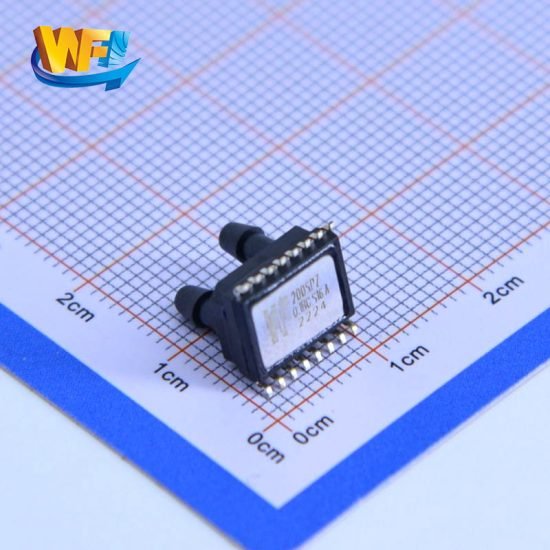カタログ
1. Measurement Principles of the Chip in Pneumatic Presses
1.1 Chip Package Overview
The MEMS differential pressure sensor chip in comes in an SOP16 or DFN package with dual micro-port barbs for pressure lines, directly SMD-mounted on PCBs. Pads on the chip bottom provide power, signal, and ground connections.
1.2 Microstructure and Strain Detection
A thin silicon diaphragm sits between two micro-cavities. Differential pressure causes micron-scale deflection, sensed by an integrated resistive bridge or capacitive element and converted into an electrical signal.
1.3 Signal Conditioning and Output
Built-in low-noise amplifiers and temperature compensation circuits output a standard 0.5–4.5 V analog signal or optional I²C/SPI digital interface, ready for PLC or embedded MCU integration.
1.4 Temperature Drift and Linearization
Calibration data stored in on-chip EEPROM compensates for temperature drift and zero offset, ensuring accuracy better than 0.2% FS from -40 °C to +125 °C.
2. Performance Advantages and Requirements
2.1 High Integration and Lightweight
The chip’s compact package and micro-barb ports reduce volume and weight, ideal for miniaturized pneumatic modules.
2.3 Vibration and Shock Resistance
The silicon MEMS structure resists up to 20 g shock and 10 g vibration, adapting to the dynamic switching of pneumatic presses.
2.4 Cost-effectiveness and Mass Production
Standard semiconductor fabrication and SMD assembly drive down per-unit costs, enabling scalable deployments.

3. Mounting and Reflow Soldering Considerations
3.1 PCB Design and Layout
Allocate clearance around the chip for unobstructed port access.
Design pads per manufacturer recommendations and compatible with no-clean, lead-free reflow paste stencils.
3.2 Reflow Profile Control
Peak temperature below 260 °C, with a total reflow time under 60 s.
Solder the electrical pads first, then secure the port interfaces with low-temperature adhesive or localized soldering.
3.3 Tubing Connection and Sealing
Use soft silicone tubing sized to fit micro-barbs with at least 3 mm insertion depth.
Reinforce connections with miniature clamps or heat-shrink tubing to prevent vibration-related loosening.
3.4 ESD and Cleaning
Follow strict ESD protocols before and after placement, and remove flux residue with ionized air or IPA.
Avoid chlorine-based cleaners to protect MEMS structures.
4. Case Studies and Performance Validation
4.1 Small-scale Pneumatic Assembly Monitoring
On a smart device housing line, the sensor chip tracked cylinder force to ensure proper insertion, boosting yield by 5%.
4.2 Online Diagnosis and Alerts
Deviation of 10% from nominal differential pressure triggers system alerts for potential line blockages or leaks, enabling fast maintenance.
4.3 Data Integration and Cloud Platform
I²C data is converted by an MCU and sent via MQTT to the cloud, where analytics predict equipment health.
4.4 Long-term Stability Testing
After 3000 hours of operation, drift remained under 0.5% FS, confirming suitability for high-cycle applications.
結論
The MEMS differential pressure sensor chip in offers compact integration, rapid response, robust interference immunity, and cost-effective mass production for pneumatic press applications. Proper PCB layout, controlled reflow soldering, secure tubing, and ESD practices are essential to ensure reliable performance. This solution provides precise, lightweight, and efficient monitoring support for automated assembly processes.
上記の紹介は、圧力センサー技術のアプリケーションの表面をなぞっただけです。私たちは、さまざまな製品で使用されているさまざまなタイプのセンサー素子、それらがどのように機能するか、そしてそれらの長所と短所を引き続き調査していきます。ここで説明する内容についてさらに詳しく知りたい場合は、このガイドの後半にある関連コンテンツをご覧ください。時間がない場合は、ここをクリックしてこのガイドの詳細をダウンロードすることもできます。 空気圧センサー製品PDFデータ。
他のセンサー技術の詳細については、こちらをご覧ください。 センサーページにアクセスしてください。

